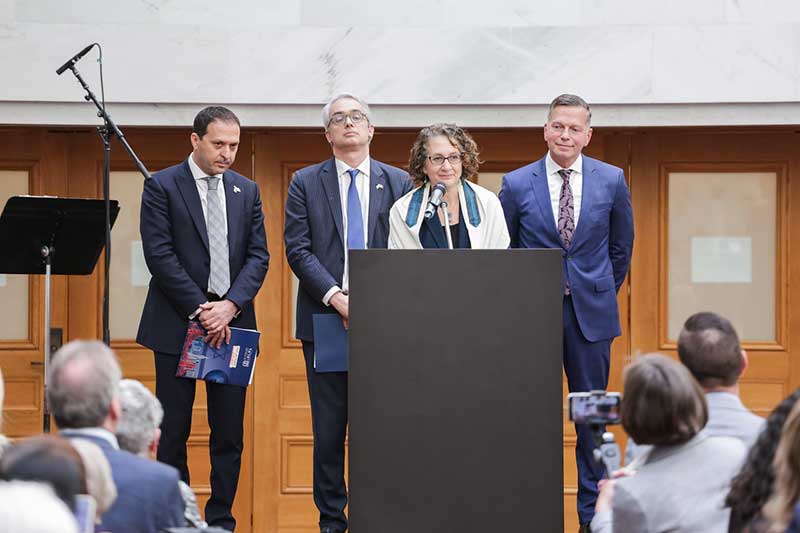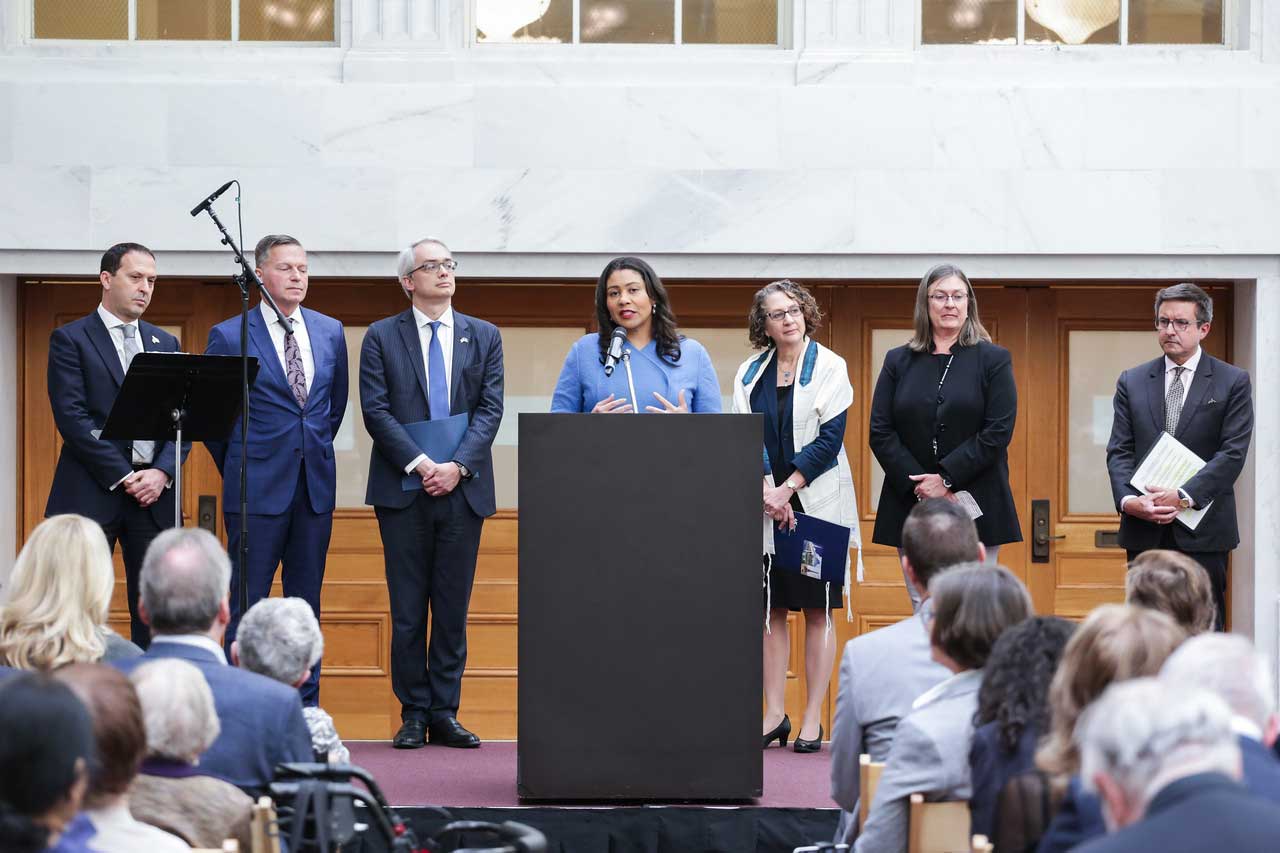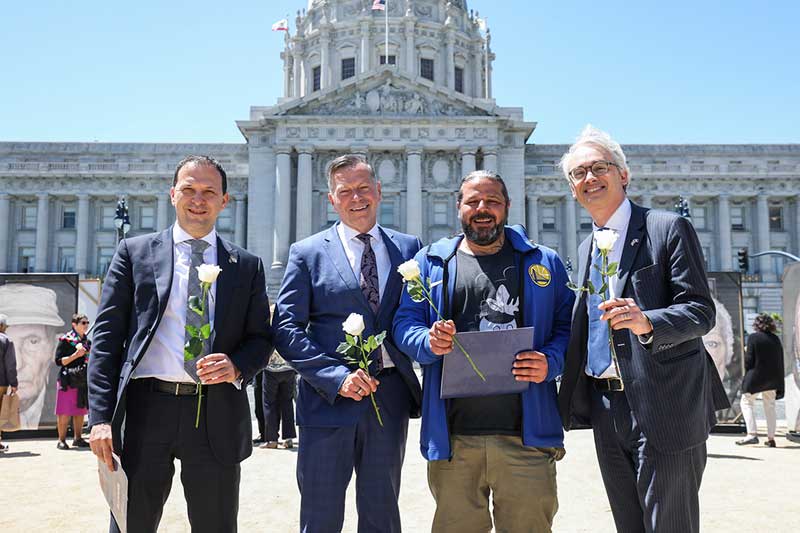LEST WE FORGET, the message echoing around the San Francisco City Hall was clear: nobody should ever forget the Holocaust and the pain and suffer it caused to the Jewish community and to the world.
The project, by German-Italian photographer Luigi Toscano, is a testament to all survivors, their families and stories. It represents the voice of six millions victims of the systematic, bureaucratic, state-sponsored persecution by the Nazi regime and its collaborators. The word “Holocaust” is of Greek origin and is made of the Greek words “holos” (whole) and “kaustos” (burned), historically used to describe a sacrificial offering burned on an altar. Since 1945, the word stands for racism, persecution, and mass killing.
Toscano’s exhibit was brought to the United States in 2018, first in New York City, at the United Nations Headquarters, followed by Washington, DC where more than 120 portraits were placed along the Lincoln Memorial Reflecting Pool. It was then moved to Boston and eventually to San Francisco, before touring other cities worldwide, from Seattle, Chicago, Pittsburgh, to Vienna and Mainz.

Sigrid Savelsberg, Director of the Goethe Institute. Photo credits to Barak Shrama
On May 2nd, at noon, the South Light Court of the San Francisco City Hall was home to a moment of remembrance of the Yom Hashoah, with a program featuring, among others, violinist Rebecca Jackson and Annemarie, a local survivor portrayed in the exhibit.
The story behind LEST WE FORGET is the one of a man who decided to show the faces of 300 Holocaust survivors from the United States, Germany, Ukraine, Russia, Israel, Belarus, Austria, and the Netherlands. Luigi Toscano told the behind-the-scene of his project in an emotional speech shared with survivors, locals, and students. “Four years ago, nobody could believe in me and in this project. I was told this would be a big failure. It was tough to believe in myself at that point, and I was ready to give up my courage and my passion. When I tried to reach out to outlets and institutions, I did not get any answer. However, one day, I received a call from one survivor, who said he was interested in being part of the project. I am the only one left in the family, he told me. I changed my mind and decided to give it a try. One of the most beautiful stories I can share is the one of this man, the one who gave me the strength to kick off the project. In Berlin, his photo was placed next to another survivor’s: accidentally the two, who had known each other for a long time, were reunited again 60 years later thanks to this exhibit. That man passed away two months after the Berlin exhibition, that’s why I want to dedicate this project to him, because he believed in me and pushed me forward.”

Mayor London Breed during the Program Ph credits to Barak Shrama
There are 15 portraits displayed at the Civic Centre in San Francisco (until May 15th), alongside events and panels at the Goethe Institut San Francisco. Michael Pappas, Executive Director of the San Francisco Interfaith Council, opened the program with a spotlight on Toscano’s courage and his fight against all the movements that promote racism and anti-semitism. Luigi was named an “agent of change,” for being able to stand up against the silence that sometimes covers the stories of both the victims and the survivors.
San Francisco is today a sanctuary city and stands for everybody’s rights, and there is no place here for any form of anti-semitism or racism in general. For those who don’t know, inspired by the 1995 UN Fourth World Conference on Women in Beijing, the women of San Francisco organized a successful effort to adopt a local ordinance reflecting the principles of the Convention on the Elimination of All Forms of Discrimination Against Women. In 1998, San Francisco became the first municipality in the world to pass such a measure.

From far left, Consul General of Israel, Consul General of Germany, Luigi Toscano, and Consul General of Italy. Photo credits to Barak Shrama
It is not a surprise that also Mayor London Breed took a moment to express the gratefulness of all people in San Francisco, who can witness Toscano’s impactful and powerful exhibition and can learn the stories of those who lived that tragedy. The Mayor’s words also underlined the importance of raising awareness at this moment in history when new episodes of anti-semitism, like the shootings in Pittsburgh and San Diego, are taking place: “The Jewish people are supported and celebrated, and diversity is a good thing for the city and for the nation. However, we must remain diligent so that these horrific things do not happen again,” Mayor Breed concluded.
Hans-Ulrich Südbeck, Germany’s Consul General, walked the audience through a moment of historical memories: it wasn’t easy for Germans to face what happened under the Nazi regime, however it shaped Germany as the peaceful country we know today. The Consul also stressed how nationalism and anti-tolerance are on the rise everywhere, therefore we all need to be prompt with new responses while showing how much suffering these things can cause to the world altogether. Toscano’s project is impressive to the extent that its message will be heard by generations to come for a long time. On the same note, the Director of the Goethe-Institute suggested that we can learn from our past and we all have a big responsibility and a duty, because no place is free of risk: we should all fight against polarization and discrimination, and Toscano’s exhibit is powerful for both San Francisco and the world.
In addition, the Italian Consul General, Lorenzo Ortona, was part of the program representing the European Union: “Not only is this project beautiful, but it also reminds that we are lucky to have survivors who can share their stories with us. We should never forget the six millions victims’ names and identities. It’s crucial that we raise awareness and act together against any form of violence.”
The last part of the program was all about Annemarie’s story, the survivor who was born in Germany but found a new life in San Francisco. Annemarie recalled how her family had a comfortable life until November 9th, 1938 when their dinner was interrupted by the SS Generals, who dragged her dad away, before taking him to the police station first and a prison in East Germany later. That was the beginning of a new life: when her father was released, they traveled away from their hometown to reach the safe border of Belgium. There was then another stop in England, before the family got reunited with other relatives in the Bay Area through a long journey via New York, Chicago, and Oakland. Annemarie has been telling her story around the US since the 1990s, sharing with students and families a special message: “We must never forget, but we have to forgive.”
Lest We Forget (Non dimentichiamo). Il messaggio che riecheggiava nel municipio di San Francisco era chiaro: nessuno dovrebbe mai dimenticare l’Olocausto e il dolore e la sofferenza che ha causato alla comunità ebraica e al mondo.
Il progetto, realizzato dal fotografo italo-tedesco Luigi Toscano, è la testimonianza di tutti i sopravvissuti, delle loro famiglie e delle loro storie. Rappresenta la voce di sei milioni di vittime della sistematica e burocratica persecuzione, voluta dallo Stato, messa in atto dal regime nazista e dai suoi collaboratori. La parola “Olocausto” ha origine greca ed è composta dalle parole greche “holos” (intero) e “kaustos” (bruciato), storicamente usate per descrivere un’offerta sacrificale bruciata su un altare. Dal 1945, la parola “kaustos” sta per razzismo, persecuzione e uccisioni di massa.
La mostra di Toscano è stata portata negli Stati Uniti nel 2018, prima a New York City, presso la sede delle Nazioni Unite, seguita da Washington, dove sono stati collocati più di 120 ritratti lungo il Lincoln Memorial Reflecting Pool. Successivamente è stata spostata a Boston e infine a San Francisco, prima di far visita ad altre città in tutto il mondo, da Seattle, Chicago, Pittsburgh, a Vienna e Magonza.
Il 2 maggio, a mezzogiorno, la South Light Court del San Francisco City Hall ha ospitato un momento di ricordo dello Yom Hashoah, con un programma che ha visto, tra gli altri, la violinista Rebecca Jackson e Annemarie, una sopravvissuta locale ritratta nella mostra.
La storia di “Non dimentichiamo” è quella di un uomo che ha deciso di mostrare i volti di 300 sopravvissuti all’Olocausto provenienti da Stati Uniti, Germania, Ucraina, Russia, Israele, Bielorussia, Austria e Paesi Bassi. Luigi Toscano ha raccontato il dietro le quinte del suo progetto in un discorso emozionale che ha condiviso con i sopravvissuti, la gente del posto e gli studenti. “Quattro anni fa, nessuno credeva in me e in questo progetto. Mi è stato detto che sarebbe stato un grande fallimento. Era difficile credere in me stesso a quel punto, ed ero pronto a rinunciare al mio coraggio e alla mia passione. Quando ho cercato di raggiungere i punti vendita e le istituzioni, non ho ricevuto alcuna risposta. Tuttavia, un giorno, ho ricevuto una chiamata da un sopravvissuto, che mi ha detto di essere interessato a far parte del progetto. Sono l’unico rimasto in famiglia, mi disse. Ho cambiato idea e ho deciso di riprovarci. Una delle storie più belle che posso condividere è quella di quest’uomo, colui che mi ha dato la forza di dare il via al progetto. A Berlino, la sua foto è stata posta accanto a quella di un altro sopravvissuto: casualmente i due, che si conoscevano da tempo, si sono riuniti nuovamente 60 anni dopo grazie a questa mostra. Quell’uomo è morto due mesi dopo la mostra di Berlino, ecco perché voglio dedicargli questo progetto, perché lui ha creduto in me e mi ha spinto a continuare”.
Ci sono 15 ritratti esposti presso il Centro Civico di San Francisco (fino al 15 maggio), accanto agli eventi e ai pannelli del Goethe Institut di San Francisco. Michael Pappas, direttore esecutivo del Consiglio Interreligioso di San Francisco, ha aperto il programma con un focus sul coraggio di Toscano e la sua lotta contro tutti i movimenti che promuovono il razzismo e l’antisemitismo. Luigi è stato chiamato “agente di cambiamento”, per aver saputo resistere al silenzio che a volte copre le storie delle vittime e dei sopravvissuti.
San Francisco è oggi una città santuario e rappresenta i diritti di tutti, e qui non c’è posto per alcuna forma di antisemitismo o razzismo in generale. Per chi non lo sa, ispirate dalla quarta Conferenza mondiale delle Nazioni Unite sulle donne a Pechino nel 1995, le donne di San Francisco si sono adoperate con successo perché si adottasse un’ordinanza locale che riflettesse i principi della Convenzione sull’eliminazione di tutte le forme di discriminazione contro le donne. Nel 1998, San Francisco è stata la prima municipalità al mondo ad approvare tale misura.
Non è una sorpresa che anche il sindaco London Breed abbia colto l’occasione per esprimere la gratitudine di tutti i cittadini di San Francisco, che possono assistere all’impressionante e potente mostra di Toscano e conoscere le storie di coloro che hanno vissuto quella tragedia. Le parole del sindaco hanno anche sottolineato l’importanza di sensibilizzare l’opinione pubblica in questo momento storico in cui si stanno verificando nuovi episodi di antisemitismo, come le sparatorie di Pittsburgh e San Diego: “Il popolo ebraico viene sostenuto e celebrato, e la diversità è un bene per la città e per la nazione. Tuttavia, dobbiamo stare attenti affinché queste cose orribili non si ripetano”, ha concluso il sindaco Breed.
Hans-Ulrich Südbeck, Console generale della Germania, ha accompagnato il pubblico attraverso un momento di memoria storica: non è stato facile per i tedeschi affrontare ciò che è successo sotto il regime nazista, ma questo ha reso la Germania il paese pacifico che conosciamo oggi. Il Console ha anche sottolineato come il nazionalismo e l’intolleranza siano in aumento ovunque, quindi tutti noi dobbiamo essere pronti a dare risposte nuove e a mostrare quante sofferenze queste cose possono causare al mondo intero. Il progetto di Toscano è impressionante nella misura in cui il suo messaggio sarà ascoltato per lungo tempo dalle generazioni future. Allo stesso modo, il direttore del Goethe Institut ha suggerito che possiamo imparare dal nostro passato e tutti noi abbiamo una grande responsabilità e un dovere, perché nessun luogo è esente da rischi: tutti noi dovremmo lottare contro la polarizzazione e la discriminazione, e la mostra di Toscano è importante sia per San Francisco che per il mondo.
Il Console Generale d’Italia, Lorenzo Ortona, ha fatto parte del programma in rappresentanza dell’Unione Europea: “Non solo questo progetto è bello, ma ci ricorda anche che siamo fortunati ad avere sopravvissuti che possono condividere con noi le loro storie. Non dobbiamo mai dimenticare i nomi e le identità di sei milioni di vittime. È fondamentale sensibilizzare e agire insieme contro ogni forma di violenza”.
L’ultima parte del programma è stata dedicata alla storia di Annemarie, la sopravvissuta nata in Germania ma che ha trovato una nuova vita a San Francisco. Annemarie ha ricordato come la sua famiglia abbia avuto una vita agiata fino al 9 novembre 1938 quando la cena fu interrotta dai generali delle SS, che trascinarono via suo padre, per portarlo prima alla stazione di polizia e poi in una prigione nella Germania dell’Est. Quello fu l’inizio di una nuova vita: quando suo padre fu rilasciato, si allontanarono dalla città natale per raggiungere il confine sicuro del Belgio. Ci fu poi un’altra sosta in Inghilterra, prima che la famiglia si ricongiungesse con altri parenti nella Bay Area attraverso un lungo viaggio attraverso New York, Chicago e Oakland. Annemarie racconta la sua storia negli Stati Uniti dagli anni ’90, condividendo con studenti e famiglie un messaggio speciale: “Non dobbiamo mai dimenticare, ma dobbiamo perdonare”.


































